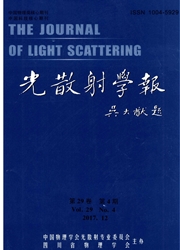

 中文摘要:
中文摘要:
熔盐法对sol-gel法生成的前驱物处理合成新颖的叶片状的氧化锌纳米结构,TEM照片显示其长度300—500nm,宽度为50—80nm,两头尖端约呈25°夹角,形状基本沿中轴呈中心对称。其生长过程进行了研究:弯曲了的ZnO纳米棒闭合形成框架结构,框架内沿中轴方向并排生长的ZnO纳米线填满框架内的空隙形成叶片状的氧化锌纳米结构。Raman谱测量发现该结构是晶化的六角相氧化锌。对叶片状的氧化锌的声子限制效应进行了研究,并与纳米颗粒氧化锌予以比较。435cm^-1的E2峰的Fano不对称具有正的Fano耦合系数。发现在585nm处出现光致发光峰,归于ZnO纳米结构中氧缺陷的作用。
 英文摘要:
英文摘要:
A novel leaf shape- structured ZnO nanocrystal (LSSZN) was synthesised by molten -salt method growth from the precursor produced by sol -gel method. TEM image shows that LSSZN is symmetric along central long axis with length of 300 - 500 nm, width of 50 to 80 nm, and the end angle of about 25°. The formation process of the leaf shape- structure is described as follows. Two ZnO nanorods bend to each other to form the leaf- shaped frame. Many nanowires grow along the long axis within the frame, and finally fill the whole frame in parallel arrangement to form the leaf shape- structured ZnO nanocrystal. Raman spectroscopy indicates the leaf- shaped nanocrystal has hexagonal phase structure. Lineshapes of the 435cm^-1 E2 modes for both LSSZN and ZnO nanocrystal were found to have Fano asymmetry. However, the former peak is sharply cutoff on the low - energy side, showing negative Fano coupling coefficient; while the latter is sharply cut - off on the high- energy, showing positive Fano coupling coefficient. Photoluminance spectrum reveals a peak centered at 585 nm. The origin of the emission is attributed to oxygen vacancies in LSSZN.
 同期刊论文项目
同期刊论文项目
 同项目期刊论文
同项目期刊论文
 期刊信息
期刊信息
